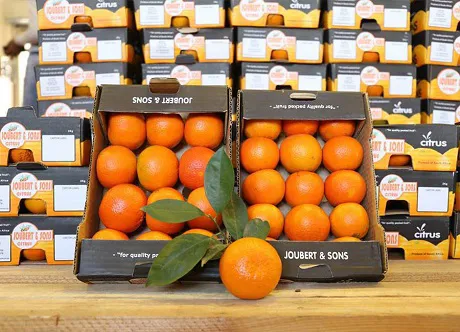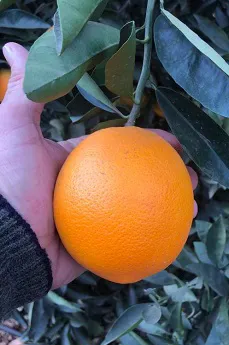At Joubert & Sons, in the Mpumalanga Lowveld, the citrus season has been between two and four weeks earlier than usual, except on the Nadorcotts, notes Lionel Eva, general manager, and it will probably end a month earlier, especially seeing that hail ruined their Valencia crop just before Christmas last year.

A hailstorm accompanied by a tornado during late December, and again in early January, took down many hectares of hail netting and damaged their Valencias to an initially unsuspected extent. “On our Turkey Valencias we’ve lost 85 to 90% of the crop – and we were in fact looking at a good crop of around 4,000 tonnes. Now we get a packout of around 10%, which barely covers packhouse costs, but at least we’re able to send it for processing and at least make something on the crop, but not nearly what we’d hoped for.”
“Overall, we’re 30% down on our estimate for this season. It’s been, at times, a frustrating and disappointing season.”
Witkrans late navel well-suited to Far Eastern requirements Their late navels are under hail netting, and Lionel expects much from the Witkrans late navel (pictured right), a South African mutation of the Palmer.
Their late navels are under hail netting, and Lionel expects much from the Witkrans late navel (pictured right), a South African mutation of the Palmer.
“We expect between 120,000 and 130,000 cartons to be packed. There’s big demand for Witkrans in Malaysia and China because it has a thin skin, very firm fruit and good Brix. You can let it hang a long time on the tree and it can give you a longer packing season.”
Lionel points out that the Witkrans harvest only started by the end of July last year, and this year it’s already due to commence next week, mid-June.
“It’s a variety that’s growing in popularity across the country. We’ve seen in past seasons that it can achieve $1.50 over other navel varieties.”
He’s less impressed with some of their other varieties, particularly the Glen Ora late navel: “We just can’t get them to set and we’ve tried everything. I’m giving them a last chance this year, but nothing’s been working for us on them and they’re under net – we can better use that investment, we feel.”
Early navels make way for late mandarins
Similarly, early navels are on its way out. They aren’t under net and also took a knock from the hail and wind. Half of the early navel orchards at Joubert & Sons have been taken out, about 50ha.
“We’re competing with Egyptian and Spanish Valencias during that period plus we have to de-green them, which limits their shelf life. We just can’t afford to carry on with early navels and in our area mandarins do well. We probably carried on too long with early navels, hoping for a magic recipe.”
The trees will be topworked to Orri and Nadorcott, with Bahianinha interstock, during springtime in October. The new late mandarin orchards can then be in production within 36 months.
Across the Lowveld early navels are being replaced by late mandarins. Joubert & Sons already have 250ha of late mandarins, benefiting from a slightly earlier harvest than Ohrigstad, Burgersfort and Letsitele. The area has a bit more cold units and a bit more humidity, Lionel says, and their first Nadorcotts will start in two weeks.
Young lemon orchards Their lemon campaign, a new addition to their portfolio, is winding down. Trees are only three years old, and initially they thought to strip the trees of fruit but the nice set on the trees changed their mind.
“We had a nice crop, about 15 tonnes per hectare. You can’t expect too much of such young trees and it’s not all jubilee, there was some wind damage, but half of the 80% packouts we sent as second grade fruit to processing programmes in the Middle East where the price came to about R3,100 [185 euros] per tonne, which isn’t bad.”
“Fruit on young trees are smaller and due to size, we weren’t able to take advantage of Ramadan, which can add $1.50 to the price. We peaked at 168 while they were looking for 88s and 110s. Next year, when our trees are older, it will be different."
The impact of the hail and the changes to their cultivar portfolio have been a lot to digest this season, and consequently they have decided to consolidate their activities over the next 24 months.
Navels and Valencias are packed at the Joubert & Sons packhouse outside Nelspruit, and they send their Nadorcotts to be packed at the Naranja packhouse in Burgersfort.
The company only involves itself in production, believing best results lie in specialisation. Marketing of their fruit they leave to Corefruit and ANB Investments (owner of the ClemenGold brand).
“I think they’re world leaders in what they do,” he says. “We focus on growing.”
 For more information:
For more information:
Lionel Eva
Joubert & Seuns
Tel: +27 82 907 3817
Email: gm@joubertenseuns.co.za
https://joubertenseuns.co.za/citrus/
